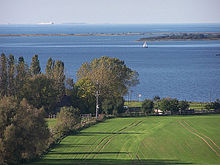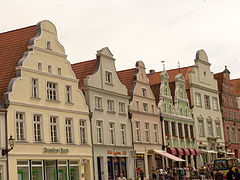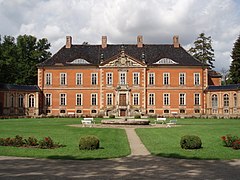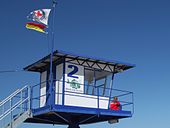
The Mecklenburg Baltic Sea coast extends from the Traveförde on the state border with Schleswig-Holstein to the beginning of the peninsula Fischland-Darß-Zingst at Ribnitz-Damgarten. The overseas port city belongs to it Rostockwho have favourited the largest city Mecklenburg-Western Pomerania is, the Wismar Bay with the Hanseatic city Wismar and island Poel, the Salzhaff and the coastal ridge cooling.

Regions


The following sub-regions belong to the Mecklenburg Baltic Sea coast travel region (from west to east):
- Klützer Winkel - the Baltic Sea strip west of Wismar to the mouth of the Trave.
- Wismar Bay (with hinterland) - this is where the Hanseatic and independent city of Wismar and the holiday island are located Poel.
- cooling - Coastal terminal moraine arch (max. 130 m high) at Bad Doberan, Heiligendamm and Kühlungsborn
- Rostock Heath - Forest and heathland north-east of Rostock
- the peninsula Fischland-Darß-Zingst historically, belongs partly to Mecklenburg, partly to Western Pomerania; it is excluded from this travel guide and viewed as a separate travel region.
places


- Rostock - largest city in Mecklenburg-Western Pomerania, located on the Warnow; has an important overseas port with Warnemünde.
- Wismar - Hanseatic city north of Schwerin. Starting point for excursions to the island Poel.
- Guestrow - "Barlachstadt" with a renaissance castle, market with colorful gabled houses and cathedral.
- Boltenhagen - Sea spa north of Grevesmühlen.
- Bad Doberan - Starting point of the "Molli" bathing railway.
- Dierhagen - Ostseebad on Fischland.
- Graal-Müritz - Sea spa.
- Grevesmühlen
- Heiligendamm - Germany's oldest seaside resort, in the 19th century a meeting place for German and international high society with elegant spa architecture; Renewed international fame in the 21st century through the G8 meeting in 2007.
- Kühlungsborn - The terminus of the "Molli" bathing railway from Bad Doberan.
- New monastery - Romanesque monastery church Sonnenkamp.
- Nienhagen - Ostseebad east of Rostock with steep coast and ghost forest
- Rerik - Ostseebad on Salzhaff.
- Ribnitz-Damgarten - City merged in 1950. Historically, Ribnitz is the Mecklenburg part, Damgarten the Western Pomerania part.
Other goals

- Poel - the seventh largest German island, a few kilometers north of Wismar.
background
language
getting there
By plane
Rostock Airport![]() (IATA: RLG), approx. 35 km south of Rostock: Scheduled flights from Munich (1 to 2 times a week). The bus line 127 of the Rebus (Rostock regional bus) runs - adjusted to the arrival times of the flights - in 35 minutes to the main station / ZOB Rostock, where there is a connection to trains and buses to other places on the Mecklenburg Baltic Sea coast.
(IATA: RLG), approx. 35 km south of Rostock: Scheduled flights from Munich (1 to 2 times a week). The bus line 127 of the Rebus (Rostock regional bus) runs - adjusted to the arrival times of the flights - in 35 minutes to the main station / ZOB Rostock, where there is a connection to trains and buses to other places on the Mecklenburg Baltic Sea coast.
For the western part of the region, the Hamburg Airport![]() (IATA: HAM) be used. Also the Berlin Brandenburg Airport
(IATA: HAM) be used. Also the Berlin Brandenburg Airport![]() (IATA: BER) is reachable.
(IATA: BER) is reachable.
By train
Intercity lines from Hamburg and Berlin run through the region. The most important railway junction is Rostock. The western Baltic coast of Mecklenburg can be reached with regional express trains from Schwerin or Lübeck. From Hamburg to Rostock, for example, it takes less than 1:50 hours to take the IC that runs every two hours, and Wismar takes around two hours with one change. From Berlin to Rostock it takes about 2:15 hours with the ICs, which only run sporadically, and about 2:40 hours with the more frequent regional express.
In the street
The most important motorway is the A 19 from direction Berlin. The last section of the A 19 to Warnemünde runs in Rostock under the Warnow and is toll road. The A 20 is the second motorway that runs through the region. It runs parallel to the Baltic coast, from Lübeck past Wismar and Rostock on towards Stralsund and Greifswald.
Those who prefer to travel a little more leisurely can take the B 105 from Lübeck / Hamburg and the B 103 or 108 from southern Mecklenburg or the Berlin-Brandenburg area.
By bicycle
The leads along the Mecklenburg Baltic Sea coast Baltic Sea Cycle Route and the Iron Curtain Europe Cycle Route.
On foot
The Long-distance hiking trail E9 leads along the Mecklenburg Baltic Sea coast.
mobility

Anyone who drives to the Baltic Sea to swim in their car should have enough change for parking machines on hand. There are very few parking spaces near the beach that are free of charge. However, the parking fees vary from place to place.
A special means of transport is the steam-powered narrow-gauge railway "Molli" from Bad Doberan via Heiligendamm to Kühlungsborn and back.
Other regional transport lines:
- RE 9: Rostock – Ribnitz-Damgarten – Stralsund – Rügen
- RB 11: Wismar – Rostock – Ticino
- RB 12: Bad Doberan – Rostock – Graal-Müritz
- In the Rostock / Güstrow area there are three S-Bahn lines that also go to Warnemünde
The bus transport in the region is mainly operated by the companies rebus (Rostock regional bus), Local bus (Northwest Mecklenburg) and VGN (Verkehrsgemeinschaft Nordvorpommern) operated.
Tourist Attractions
- The Old town of Wismar is a UNESCO World Heritage Site, including the late Gothic Nikolaikirche and the market square with water art, town hall and brick Gothic town house Alter Schwede as well as numerous other historical town houses, especially the representative gabled houses in the Renaissance style
- Also Rostock has a worth seeing Old town with numerous historical buildings (medieval city wall with Gothic Kröpeliner gate and Renaissance stone gate, Gothic Nikolaikirche (one of the oldest hall churches in the Baltic Sea region), Marienkirche, monastery of the Holy Cross, Petrikirche, late Gothic house tree house, partly Gothic, partly Baroque town hall, historicist state house)
- lighthouse Bastorf (approx. 5 km southwest of Kühlungsborn)
- Mecklenburg village: BrickVillage church from the 14th century; Dutch windmill from 1849; of the former Slavic castle, which gave the whole state of Mecklenburg its name, only an earth wall has been preserved (approx. 6 km south of Wismar)
- open air museum Klockenhagen (5 km west of Ribnitz)
- Baroque Bothmer Castle in Klütz with castle island and landscape garden (approx. 5 km southwest of Boltenhagen)
- gothic Monastery church Sonnenkamp in New monastery with stained glass from the first half of the 13th century, carved altar from the early 16th century, former provost's office (approx. 1400)
- gothic Village church (13th century) in Kirchdorf Poel
- lighthouse Warnemünde

Historic town houses in Wismar

Rostock town hall

Bastorf lighthouse

Windmill village Mecklenburg
Klockenhagen open-air museum

Bothmer Castle

Sonnenkamp Monastery Church (Neukloster)

Warnemünde lighthouse
activities
fishing
In order to be allowed to fish in Mecklenburg-Western Pomerania, you must have a fishing license. To fish with a hand rod, a fishing license and a fishing permit for the water are required, also for coastal waters such as backwaters and lagoon.
There are fishing licenses for holidaymakers or locals who do not have a regular fishing license for 28 consecutive days. They cost € 20 and are available from local offices.
The use of two hand rods is permitted, which must be supervised at all times. It is forbidden to fish without sensible utilization of the caught fish, the use of live bait fish, the keeping of the caught fish in keep nets. When fishing in and on the coastal waters, keep a distance of at least 100 m from the nearest angler. It is forbidden to moor in or on the reed belt with the boat.
Fishing permits are available at the branch offices of the State Fisheries Office, in fishing specialist shops and in the tourist information offices or spa administrations in the municipalities.
Regular events
- From mid-March to early April are in Wismar the Wismar Herring Days
- They are open from mid-March to mid-April Usedom Herring Weeks
- The Ruegener Herring weeks are from April to early May
- That is on the Saturday after Ascension Day Grand Schlemm. From the pier in Ahlbeck you can hike a 10 course menu. From Ahlbeck to Bansin, right on the beach there are 10 refreshment stations from the island's top chefs.
- The third weekend in July is the fishing festival Gaff rig in Greifswald with freshly caught fish from pans and smokers
- The last weekend in July is in KarlshagenHarbor party with feasts and fireworks in the inland port
- Hansesail the second weekend of August in Warnemünde, in addition to the Kiel Week, THE sailing and windjammer event on the German Baltic coast
kitchen
The cuisine of the coast is mostly hearty and simple, down-to-earth home cooking. The main ingredients are potatoes, cabbage, beets and of course freshly caught fish, especially herring.

Fish rolls are omnipresent, as Bismarck, Matjes, salmon, fish rolls, smoked fish rolls or something else. They are not only available at the snack bar, they are also sold in restaurants. The prices are between € 2 and € 5, depending on the version.
One should not leave the coast without smoked fish to have tried. There is a large selection: eel, butterfish (mostly from tropical zones), flounder, trout, halibut, mackerel, schillerlocken (belly lobes of the dogfish), stremel salmon (hot smoked salmon). When consuming smoked fish, one should also bear in mind that fish such as eels, dogfish etc. are endangered species (which should be avoided) and that eating butterfish can lead to health problems due to the high oil content.
More on the topic of kitchen can be found at: Eating and drinking in Mecklenburg-Western Pomerania
nightlife
security
Swimming
 Red and yellow flag - bathing allowed |  Red, yellow and yellow flags - swimming is prohibited for children and inexperienced swimmers |
 Red flag - bathing prohibited |  The bathing zone marking of the DLRG |
- General bathing rules and notices
- Never bathe where there is shipping traffic
- Do not let children play unsupervised on the bank or in the water
- Air mattresses and swimming aids are not safe
- The waves of incoming and outgoing ships are bigger
- Offshore winds make swimming back to shore difficult.
- Sharp-edged mussels can grow on groynes below the waterline
- Jumping and bathing at the pier is prohibited due to the high risk of injury
- Pay attention to the instructions on the rescue towers
- Do not go into the water with a very full or very empty stomach
- Rescue phone number 112
- Meaning of the flags on the beach:
- A red and yellow flag shows on the mast of a guard station Bathing allowed, the bathing area is secured by lifeguards.
- A red and yellow flag and a yellow flag signals a bathing ban for children and inexperienced swimmers.
- A single one red flag shows, bathing forbidden, due to hazards such as currents, high waves or water pollution.
- If there is one Water sports area on the beach, he's with you black and white flags delimited. Bathing and swimming is not allowed on the beach between the flags.
- Is on the beach Sun protection Of course, even when it's cool and a constant wind keeps the temperature low, the UV radiation is very intense.
- One encounters in the entire Baltic Sea Jellyfishwhich are mostly harmless. However, contact with a fire jellyfish can be very uncomfortable. After contact with a fire jellyfish, the affected areas should be treated with vinegar or shaving foam. Carefully scrape off any threads and tentacles, for example with a plastic card or with sand or salt water. Under no circumstances wash off with fresh water or alcohol. Then apply burn ointment or anti-allergic ointment and see a doctor if you feel unwell or have allergic reactions.
- When collecting Amber there is danger, since amber with the dangerous doppelganger phosphorus can be confused, which comes from sunk ammunition. If the damp phosphorus dries, it will self-ignite, so you shouldn't transport your finds in your trouser or jacket pocket, but in metal containers. It is better to dry the find on a fireproof surface. If the clothing catches fire, take it off immediately, phosphor residues on the skin must be removed quickly. The fire cannot be extinguished with water; it can best be smothered with damp sand.
Practical advice
Almost every coastal town in the region asks holidaymakers and day visitors to pay. The Tourist tax (also referred to as health resort tax, health resort card, health resort contribution or tourism contribution) is used for cleaning and maintaining the beaches, promenades and tourist infrastructure, or for free entertainment, holiday shuttles, bathing railways, beach and bathing safety, etc. The prices are between € 1 and € 3 €. The tourist tax is paid to the landlord, who also hands over the tourist card. Another possibility is the local tourist information. For day visitors, the fee is often collected from machines at the beach entrances. Each coastal town has its own regulation regarding the price and the minimum age from when you have to pay. The services are also different, in some places the toilets are free, in others not. More information is available from the local tourist information offices.
climate
The spring is cold compared to north-west Germany, in April and May there are often rough north-east winds; the summer heat is due to the proximity of the Baltic Sea moderate, but in autumn this has a warming influence. The annual rainfall decreases in a striking way towards the Baltic Sea.
trips
literature
Web links
- Ostseeferien.de - Portal of the Association of Mecklenburg Baltic Sea Baths











